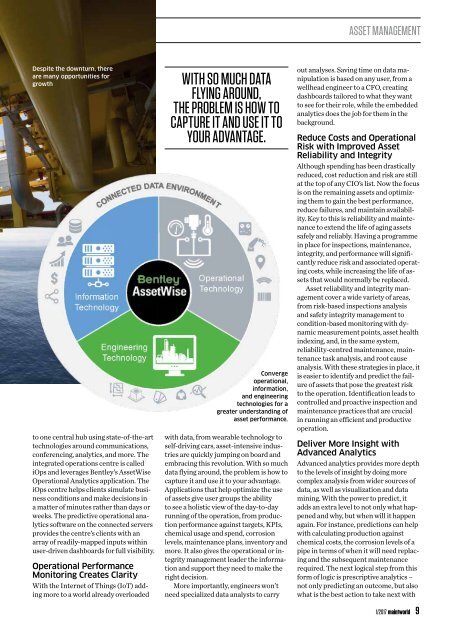Maintworld 1/2017
Create successful ePaper yourself
Turn your PDF publications into a flip-book with our unique Google optimized e-Paper software.
ASSET MANAGEMENT<br />
Despite the downturn, there<br />
are many opportunities for<br />
growth<br />
to one central hub using state-of-the-art<br />
technologies around communications,<br />
conferencing, analytics, and more. The<br />
integrated operations centre is called<br />
iOps and leverages Bentley’s AssetWise<br />
Operational Analytics application. The<br />
iOps centre helps clients simulate business<br />
conditions and make decisions in<br />
a matter of minutes rather than days or<br />
weeks. The predictive operational analytics<br />
software on the connected servers<br />
provides the centre’s clients with an<br />
array of readily-mapped inputs within<br />
user-driven dashboards for full visibility.<br />
Operational Performance<br />
Monitoring Creates Clarity<br />
With the Internet of Things (IoT) adding<br />
more to a world already overloaded<br />
WITH SO MUCH DATA<br />
FLYING AROUND,<br />
THE PROBLEM IS HOW TO<br />
CAPTURE IT AND USE IT TO<br />
YOUR ADVANTAGE.<br />
Converge<br />
operational,<br />
information,<br />
and engineering<br />
technologies for a<br />
greater understanding of<br />
asset performance.<br />
with data, from wearable technology to<br />
self-driving cars, asset-intensive industries<br />
are quickly jumping on board and<br />
embracing this revolution. With so much<br />
data flying around, the problem is how to<br />
capture it and use it to your advantage.<br />
Applications that help optimize the use<br />
of assets give user groups the ability<br />
to see a holistic view of the day-to-day<br />
running of the operation, from production<br />
performance against targets, KPIs,<br />
chemical usage and spend, corrosion<br />
levels, maintenance plans, inventory and<br />
more. It also gives the operational or integrity<br />
management leader the information<br />
and support they need to make the<br />
right decision.<br />
More importantly, engineers won’t<br />
need specialized data analysts to carry<br />
out analyses. Saving time on data manipulation<br />
is based on any user, from a<br />
wellhead engineer to a CFO, creating<br />
dashboards tailored to what they want<br />
to see for their role, while the embedded<br />
analytics does the job for them in the<br />
background.<br />
Reduce Costs and Operational<br />
Risk with Improved Asset<br />
Reliability and Integrity<br />
Although spending has been drastically<br />
reduced, cost reduction and risk are still<br />
at the top of any CIO’s list. Now the focus<br />
is on the remaining assets and optimizing<br />
them to gain the best performance,<br />
reduce failures, and maintain availability.<br />
Key to this is reliability and maintenance<br />
to extend the life of aging assets<br />
safely and reliably. Having a programme<br />
in place for inspections, maintenance,<br />
integrity, and performance will significantly<br />
reduce risk and associated operating<br />
costs, while increasing the life of assets<br />
that would normally be replaced.<br />
Asset reliability and integrity management<br />
cover a wide variety of areas,<br />
from risk-based inspections analysis<br />
and safety integrity management to<br />
condition-based monitoring with dynamic<br />
measurement points, asset health<br />
indexing, and, in the same system,<br />
reliability-centred maintenance, maintenance<br />
task analysis, and root cause<br />
analysis. With these strategies in place, it<br />
is easier to identify and predict the failure<br />
of assets that pose the greatest risk<br />
to the operation. Identification leads to<br />
controlled and proactive inspection and<br />
maintenance practices that are crucial<br />
in running an efficient and productive<br />
operation.<br />
Deliver More Insight with<br />
Advanced Analytics<br />
Advanced analytics provides more depth<br />
to the levels of insight by doing more<br />
complex analysis from wider sources of<br />
data, as well as visualization and data<br />
mining. With the power to predict, it<br />
adds an extra level to not only what happened<br />
and why, but when will it happen<br />
again. For instance, predictions can help<br />
with calculating production against<br />
chemical costs, the corrosion levels of a<br />
pipe in terms of when it will need replacing<br />
and the subsequent maintenance<br />
required. The next logical step from this<br />
form of logic is prescriptive analytics –<br />
not only predicting an outcome, but also<br />
what is the best action to take next with<br />
1/<strong>2017</strong> maintworld 9

















